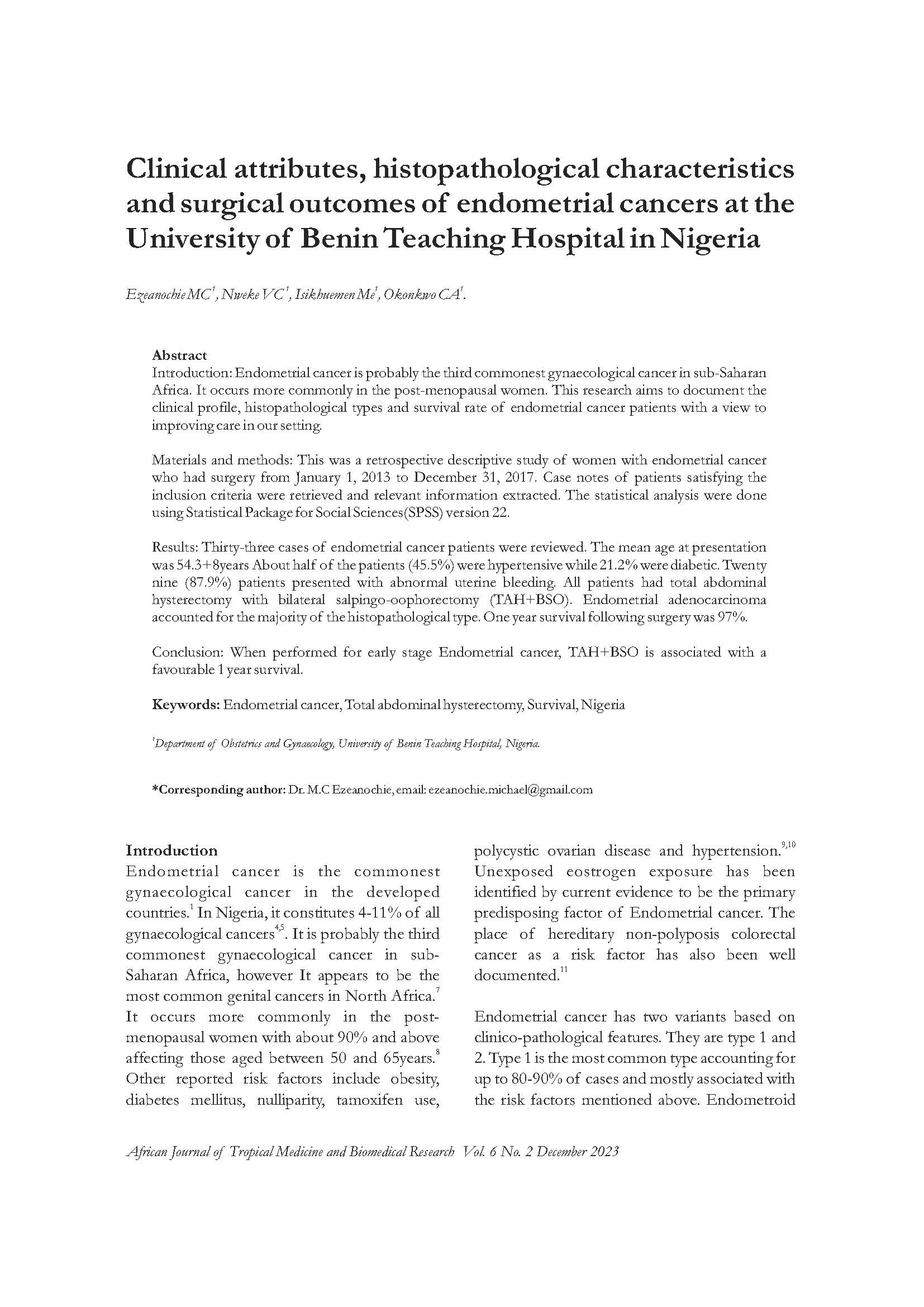Clinical attributes, histopathological characteristics and surgical outcomes of endometrial cancers at the University of Benin Teaching Hospital in Nigeria
DOI:
https://doi.org/10.4314/ajtmbr.v6i2.6Keywords:
Endometrial cancer, Total abdominal hysterectomy, Survival, NigeriaAbstract
Introduction: Endometrial cancer is probably the third commonest gynaecological cancer in
sub-Saharan Africa. It occurs more commonly in the post-menopausal women. This research aims to
document the clinical profile, histopathological types and survival rate of endometrial cancer
patients with a view to improving care in our setting.
Materials and methods: This was a retrospective descriptive study of women with endometrial cancer who had surgery from January 1, 2013 to December 31, 2017. Case notes of patients satisfying the inclusion criteria were retrieved and relevant information extracted. The statistical analysis was done using Statistical Package for Social Sciences (SPSS) version 22.
Results: Thirty-three cases of endometrial cancer patients were reviewed. The mean age at presentation was 54.3+8years About half of the patients (45.5%) were hypertensive while 21.2% were diabetic. Twenty-nine (87.9%) patients presented with abnormal uterine bleeding. All patients had total abdominal hysterectomy with bilateral salpingo-oophorectomy (TAH+BSO). Endometrial adenocarcinoma accounted for the majority of the histopathological type. One year survival
following surgery was 97%.
Conclusion: When performed for early-stage Endometrial cancer, TAH+BSO is associated with a favourable 1-year survival.
References
WHO. GLOBOCAN 2018: Latest Global cancer data 2018 http://globocan.iarc.fr/pages/fact_sheets_population.aspx
Saad Alshahram, Amr S. Solomon. Change in uterine cancer incidence rates in Egypt: Obstetrics and Gynecology Interntional, 2018, Article ID 3632067.
Meye JF, Mabickan BM, Belembaogo E, Minko-Mi-Etoua DI, Engingah-Beko T, Minko-Mi-Etoua D. Endometrial carcinoma in Gabon. A study of 34 cases in 11years: 1988-1998. Santé, 2000;10:43-5
Yakasai IA, Ugwu EA, Otubu J. Gynaecological malignancies in Aminu Kano Teaching Hospital. A 3-year review. Niger J clin pract, 2013; 16: 63-6.
Ugwu EO, Iferikigwe ES, okeke TC, Ugwu AO, Okezie OA, Agu PU. Pattern of gynaecological cancers in University of Nigeria Teaching Hospital, Enugu, South-Eastern Nigeria. Niger J med, 2011;20:266-9.
Abdul Adogie Muhammad, Oguntayo O, Adekunle, Samaila O Modupeola, Umar Muhammad Sarkinpawa Zulaiha, Adamu Abdullahi; sub-saharan. A diary of endometrial malignancies in Zaria, Northern Nigeria. African journal of medicine, 2017;4:43-46.
Zaki A, Gabon A, Ghanem E, Moemenm, Shehata G. Abdominal obesity and endometrial cancer in Egyptian females with post-menopausal bleeding. Nutr cancer, 2011:63:1272-8.
Parkin DM, Bray F, Ferlay J, et al.(2005). Global cancer statistics, 2002. CA cance J clin 55:74-108.
Olson SH, Trevisan M etal. Body mass index, weight gain, and risk of endometrial cancer. Nutrition & cancer, 1995;23:141-149.
Rosato V, Zucchetto A, Bosetti C, et al. metabolic syndrome and Endometrial cancer risk. Ann Oncol, 2011;22:887889.
Lynch HT, Lynch P, Lanspa SJ, Syndr CL, Lynch JF, Boland CR. Review of the Lynch Syndrome: history, molecular genetics, screening, differential diagnosis and medicolegal ramifications. Clin Genet, 2009; 76:1-18.
American cancer society (ACS) publication, cancer facts 7 & figures 2019.
Sean Kehoe. Endometrial cancer; In Dewhurst Textbook of Obstetrics and Gynaecology, Ninth Edition. Edited by D. Keith Edmonds, Christoph Lees and Tom Bourne. Copyright 2018 John Wiley’s & sons ltd.
Sorosky JI. Endometrial cancer. Obstet Gynecol, 2012; 120(2):383–397.
Reeves GK, Pirie K, Beral V, et al. Cancer incidence and mortality in relation to body mass index in the Million Women Study: Cohort study. BMJ, 2007;335:1134.
Lewington S. et al.. The Burden of Hypertension and Associated Risk for Cardiovascular Mortality in China. JAMA Intern. Med, 176, 524–532 (2016).
GBD 2013 Mortality and Causes of Death Collaborators. Global, regional, and national age-sex specific all-cause and cause-specific mortality for 240 causes of death, 1990–2013: a systematic analysis for the Global Burden of Disease Study. Lancet, 2015; 385: 117–171.
McCann S. E. et al.. Diet in the epidemiology of endometrial cancer in western New York (United States). Cancer Causes Control, 2000; 11:965–974.
Furberg A. S. & Thune I. Metabolic abnormalities (hypertension, hyperglycemia and overweight), lifestyle (high energy intake and physical inactivity) and endometrial cancer risk in a Norwegian cohort. Int. J Cancer, 2003; 104: 669–676.
Fortuny J. et al.. Risk of endometrial cancer in relation to medical conditions and medication use. Cancer Epidemiol. Biomarkers Prev, 2009; 18: 1448–1456.
Beral V, Hannaford P, Kay C. Oral contraceptive use and malignancies of the genital tract: results from the Royal College of General Practitioners’ Oral Contraception study. Lancet, 1988; 2:1331-5.
Khati NJ, et al; Expert Panel on Women's Imaging. ACR Appropriateness Criteria: abnormal vaginal bleeding. Reston, Va.: American College of Radiology, 2014:1–13.
American College of Obstetricians and Gynecologists. The role of transvaginal ultrasonography in the evaluation of postmenopausal bleeding. ACOG Committee Opinion No. 440, August 2009. Obstet Gynecol, 2009;114:409–411.
Practice Bulletin No. 149: Endometrial cancer. Obstet Gynecol, 2015;125(4):1006–1026.
Kitchener H, Swart AM, Qian Q, Amos C, Parmar MK. Efficacy of systematic pelvic lymphadenectomy in endometrial cancer (MRC ASTEC trial): a randomized study. Lancet, 2009;373:125–136.
TY - JOUR - Ayodele, Adekanbi - Alani, Jimoh - Ajani, Mustapha - Olubukola, Fawole PY Endometrial Cancer in Ibadan: Epidemiological and Clinico-pathological Features -10 Year Review. cancer epidemiology, 2016 edition. Florida: CRC Press

Downloads
Published
Issue
Section
License
Copyright (c) 2024 African Journal of Tropical Medicine and Biomedical Research

This work is licensed under a Creative Commons Attribution-ShareAlike 4.0 International License.
Key Terms:
- Attribution: You must give appropriate credit to the original creator.
- NonCommercial: You may not use the material for commercial purposes.
- ShareAlike: If you remix, transform, or build upon the material, you must distribute your contributions under the same license as the original.
- No additional restrictions: You may not apply legal terms or technological measures that legally restrict others from doing anything the license permits.
For full details, please review the Complete License Terms.



